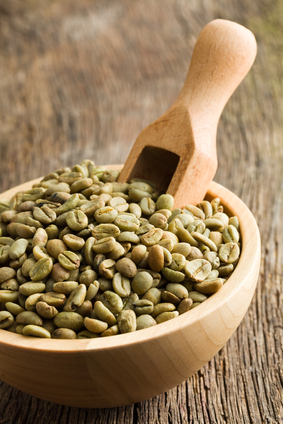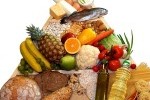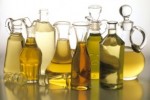Green Coffee Beans
Coffee beans or seeds of the coffee plant are the pits found inside the red fruits called cherries. These seeds/pits are referred to as “beans” because of their appearance similarity to true beans (1). Green coffee beans are coffee beans that have not yet been roasted, or simply said, raw beans.
Green Coffee Bean Extract
Green coffee beans were popularized after being featured on the Dr. Oz show, which claimed that “Green coffee bean burns fat without any exercise or diet”(2). Green coffee bean extract (GCE) has been studied for several years now, and different countries have put their work into research to identify this “magic” compound. It has been suggested that the “burning fat” effect is due to the enormous amount of Chlorogenic Acid in the green beans.
Chlorogenic Acid
Chlorogenic Acid is found to be in the highest concentrations in green coffee beans compare to other plants. Additionally, CGA is 10 times higher in green coffee beans than roasted coffee beans (3). It has been suggested that heat at about 400F destroys CGA (4). Also, decaffeinated coffees have been found to have CGA but not in the greatest amounts (5). Chlorogenic Acid (CGA) does not contain chlorine; the name came from the green color produced when CGA oxidized. Chemically speaking, Chlorogenic Acid is just a subgroup of phenols. Phenolic acids (Phenols) occur widely in nature as mixture of esters, ethers, or free acids. Caffeic, ferulic, and p-coumaric acids are phenolic compounds derived from cinnamic acid and occur naturally in the form of mono-, or diesters with the aliphatic alcohols of quinic acid, under the common name of CGA. The main subgroups of chlorogenic acids are caffeoylquinic acids (CQA), dicaffeoylquinic acids (diCQA), feruloylquinic acids (FQA) and p-coumaroylquinic acids (p-CoQA)(3). Structurally CGA is a combination of two molecules a Quinic Acid and Caffeic Acid. Interestingly, all three molecules (CGA, Caffeic Acid, and Quinic Acid) can be bioactive after CGA ingestion.
Chlorogenic Acid Properties:
Introduction
Green coffee beans have been used for many research studies to find out the efficacy of CGA to reduce excess body weight. Studies of CGA have revealed that the CGA family have several pharmacological properties, such as antioxidant activity (6-8), ability to increase hepatic glucose utilization (9-13), inhibition of HIV-1 integrase (14-16), antispasmodic activity (17), and inhibition of the mutagenicity of carcinogenic compounds (18). In addition, their corresponding chlorogenic acid lactones (CGL), which are formed during the roasting process by the loss of a water molecule from the quinic acid moiety and formation of an intramolecular ester bond, have received special attention due to their potential effects on brain function independent of the pharmacological effects of caffeine (18).
There are many positive properties assigned to this molecule but this article will focus on only a few of them: the hypotensive effect on the body and reduction of body weight due to CGA. This article also focuses on answering question of efficacy of GCE as supplementation. Additionally, the mechanism of CGA will be discussed in this detailed review.
Absorption
Biological properties of GCA depend on its absorption in the gut and on its metabolism. There are several studies which have been done on this subject, but not all studies have similar findings. In general, the absorption and metabolism of CGA is less studied. The works that have been done on the absorption extensively looked at absorption of CGA by the stomach, small intestine and large intestine. Additionally, there are some findings of microflora hydrolysis of CGA. Most studies focused on CGA and Caffeic Acid (CA) as the major metabolites in the plasma and urinary and/or fecal rats’ excretion.
Lafay et al concluded that CGA is not hydrolyzed in the stomach (only 1% is hydrolyzed in the stomach) and the small intestine, but absorbed in the stomach in its intact form and as hydrolyzed forms such as caffeic and iso-ferulic acids in the small intestine. Once reaching the cecum, CGA (15-32%) is hydrolyzed into CA and further metabolized into other aromatic acids. Transporters have not been identified yet.
The absence of CA or of its conjugated forms in the gastric vein and aorta leads the authors to the conclusion that the absorption of CGA in the stomach follows different mechanisms; it could be through the bilitranslocase, which is involved in the transport of anthocyanins in the stomach or through other unidentified organic anion transporters (19). Passive transport of CGA was also described in Caco-2 cell cultures in one of the research studies (20).
Though, other authors also suggest that CGA is absorbed without hydrolysis (21-24), some suggest that CGA was hydrolyzed in the upper digestive tract because they could not detect any CGA in plasma. To which, Lafay explains that the absence of CGA would most likely be explained by a too rapid transit through the empty stomach in these 2 studies carried out with CGA solution or brewed coffee in food-deprived rats of fasting humans. In contrast, when volunteers consumed coffee with a whole breakfast, CGA was present in urine (19).
Farah et al did their research on bioavailability of CGA from GCE in humans. The authors suggested that bioavailability of CGA from the GCE varied from 7.8 to 72.1% among subjects, with a mean 33%. Also, the authors suggested there is a possibility of higher bioavailability to be obtained in a longer study. After the consumption of GCE, almost 90% of phenolic compounds from coffee were found in plasma. Feruloylquinic acid (FQA), dicaffeoylquinic acids (diCQA) isomers and FQA were not detected in the plasma of any subject. Therefore, the authors concluded that these compounds either have poor absorption or were uptaken by liver and adipose tissue. In fact, it has been found that the human hepatic cell favors FQA uptake. Another explanation could be conversion of FQA into caffeoylquinic acid (CQA). Additionally, the authors suggested that urine may not be the preferential excretion route for intact CGA and metabolites.Farah et al concluded that CGA compounds present in the GCE are highly bioavailable in humans. A large inter-individual variation clearly exists in CGA absorption, metabolism, and kinetics in humans and requires further investigation into different genetic polymorphisms (3).
In conclusion about absorption, studies suggest that most of the absorption of intact CGA molecule is done in the stomach and small intestine. And hydrolyzation of molecule of CGA occurs more in the colon, where the microflora plays a significant role in it (19). Bioavailability of CGA from GCE varies between people with a mean of 33% and the authors question if there any genetic polymorphism that could play a role in this variability (3).
Functions
CGA are phenolic compounds formed by the esterification of cinnamic acids, such as caffeic, ferulic, and p-coumaric acids, with quinic acid. The major compounds of CGA in green coffee beans are 3-, 4-, and 5-caffeoylquinic acid (3-,4- and 5-CQA), 3,4-, 3,5-, and 4,5-dicaffeoylquinic acids (3,4-, 3,5-, and 4,5-diCQA), 3-,4- and 5-feruloylquinic acids (3-,4-, and 5-FQA) and 3-, 4-, and 5-p-coumaroylquinic acids (3-, 4-, and 5-p-CoQA) (3). A series of health benefits have been associated with the consumption of these major CGA compounds in the last few years, such as reduced risk of CVD, T2DM, and Alzheimer’s disease, and increased antibacterial, and anti-inflammatory activities. CGA have antioxidant activities and inhibitory effects on chemical induced carcinogenesis in vitro and vivo. Also, CGA has shown to exert positive effects in rats such as enhancement of insulin action. Some promising effects of CGA include reduction of body weight, control over LDL, increase HDL to total cholesterol ratio, and reduction of HTN which are good properties that could help to reduce Obesity and T2DM.
1. Anti-obesity Effect:
Phenolic acids are secondary metabolites, which are commonly found in plants. Many epidemiological studies have found that the consumption of fruits and vegetables high in phenolic content are associated with reduction of coronary disease, obesity and other inflammatory disorders. Ae-Sim Cho et al proposed that CGA may have an anti-obesity effect, as it is known that some phytochemicals have some anti-cancerous and weight control effects to our bodies. Cho et al conducted a randomized double blind study on 32 mice which were randomly divided to four groups and fed with Normal Diet (ND group), High Fat Diet (HF group), Fat Diet with 0.02% CA (CA group) , and Fat Diet with 0.02% CGA (CGA group). Mice were fed these diets for only 14 days. This study revealed that CA and CGA groups significantly reduced body weight compare to HF by 8% and 16% respectively. CA and CGA did not affect food intake and daily energy intake in mice that were in CA and CGA groups. The epididymal white adipose tissues weight was significantly lower in the CA and CGA groups compared to the HF control group by 22% and 46% respectively. CGA group had a significant reduction of body weight and body fat compare to the CA and ND group. Both CA and CGA groups were lower in the plasma leptin and insulin levels compare to HF group. CA and CGA groups were found to have lower TG and total cholesterol concentrations and higher HDL-cholesterol to total cholesterol ratio compared to the HF group. The CA and CGA groups were found to have lowered hepatic FAS, HMG-CoA reductase and ACAT activities vs HF group, while they elevated fatty acid b-oxidation activity. Therefore, CA and CGA inhibited fatty acids and cholesterol synthesis and stimulated fatty acids oxidation in the liver. CA and CGA groups stimulated expression of PPARa in the liver found in western blotting analysis. The authors concluded that CGA and CA exhibited a potential anti-obesity effect in high fat diet-induced mice, which may be mediated by altering plasma adipokine level and body fat distribution and down-regulating fatty acid and cholesterol biosynthesis, whereas up-regulating fatty acid oxidation and PPARa expression in the liver. CGA seemed to be a more potent and efficacious anti-obesity agent in diet-induced obese mice than caffeic acid (25). This research may have provided a little more hope in the World’s fight against obesity.
2. Hypotensive Effect:
It is well established that caffeine might cause blood pressure to spike in the hypertensive patients. However, there was a surprising finding that even though caffeine is a slightly pro-hypertensive compound, CGA and its metabolites were found to exert an anti-hypertensive effect (26,27). GCE has been shown to reduce blood pressure in humans and this effect is contributed to the metabolite ferulic acid, which increases vasoreactivity and general blood pressure lowering ability (28,29).
Suzuki et al concluded that not only did GCE diet groups show significant inhibition of increased blood pressure in hypertensive rats, but the inhibition strength was also proportional to the amount of GCE ingested by rats. The hypotensive effect observed in rats was due to the metabolites of Caffeic acid (CA) and Ferulic acid (FA), the study suggests. When CA and FA were injected into the femoral vein, FA had a marked hypotensive effect. Thus, the authors suggested that it is FA from the 5-CQA that had the hypotensive effect of orally administered 5-CQA. FA is also precursor of lignin, which forms the cell walls of plants, and is intermediate in the phenylpropanoid pathway in which synaptic acid is produced from phenylalanine. Various studies indicate that FA has a protective effect, an antioxidative effect, and antitumor activities. Suzuki et al study suggest that the hypotensive effect of FA in rats is mediated via the muscarinic acetylcholine receptors (29).
Mechanism
The exact mechanism of CGA anti-obesity, anti-diabetes functioning is not known. Several studies proposed a few mechanisms that could explain CGA properties. Ae-Sim Cho et al investigated the effect of CGA on lipid metabolism, hepatic lipid-regulating enzymes activities such as lipogenesis, fatty acid oxidation and cholesterol synthesis. The CA and CGA lowered hepatic FAS, HMG-CoA reductase and ACAT, while they elevated fatty acid b-oxidation activity. Thus, CA and CGA inhibited fatty acid and cholesterol synthesis and stimulated fatty acid oxidation in the liver (25). PPARa is one of the nuclear transcription factors that act as lipid sensors and regulate lipid metabolism. The liver is the major target tissue of PPARa, and its key genes include the enzymes involved in the b-oxidation of fatty acid. Supplementation of CA and CGA stimulated the expression of PPARa in the liver of mice (25).
Studies suggest CGA was identified as a specific inhibitor of the Glucose-6-phosphate translocase component of this enzyme system in microsomes of rat liver (9-13). Gl-6-phosphate translocase inhibitors may be useful for the reduction of inappropriately high rates of hepatic glucose output often found in T2DM.
Welsh et al postulated that 5-CQA mediated dissipation of the Na+ electrochemical gradient was responsible for the observed decrease in glucose uptake in rat brush border membrane vesicles, which was suggesting that Chlorogenic Acid consumption in humans would have similar effect on intestinal glucose transport (5).
Some Limitations & Conclusion of CGA Studies
Chlorogenic Acid showed promising anti-obesity properties, in reducing body weight, TG, increasing HDL/total Cholesterol ratio and stimulating PPARa in the liver to inhibit fatty acid and cholesterol synthesis and stimulate fatty acid oxidation. CGA studies also showed some results of glucose control and increase in insulin sensitivity. Reduction in hypertension was associated with increased intake of CGA. Antioxidant activity and cancer rate reduction was associated with CGA also. Most of the studies have been done in vivo, and/or rodents. There are only a few studies that have been done on humans, which have small sample sizes. It is now obvious that increased Chlorogenic Acid consumption has anti-obesity and anti-diabetic effects on animals, but the question still remains if the studies could find similar results in large size human trials. Additionally, most studies were short and safety of increased CGA intake is not out of question. Longer human studies with large sample sizes are still needed to assess the efficacy and safety of increased CGA intake of longer term .
GCE Studies Findings and Limitations
There are several studies which have shown GCE efficacy. Many of these showed a positive effect on weight loss in their human subjects. Vinson et al conducted a randomized double blind study, in which subjects were randomly divided into three groups: placebo, low dose-750 mg/d of GCE (LD) or high dose-1050 mg/d of GCE (HD). The authors found significant reduction in body weight (-8.4 kg), BMI (-2.92) and percent body fat (-4.44%), also a small decrease in heart rate 5 (-2.56 beats/min). The subjects’ diets were recorded and caloric intake, carbohydrate, protein and fat intakes were calculated and reported to be very similar in both groups and between the arms of study. BMI for several subjects shifted from pre-obesity to the normal weight (31).
Meta analysis study was done to assess the efficacy of GCE as a weight-loss supplement. This study had very strict criteria which held the authors to pick only three studies of a thousand available. All three studies have been done outside of the USA (Northway, France and United Kingdom). The total amount of subjects from the 3 studies were 142 participants, which were randomly selected to get either placebo or 200 mg/d GCE. Meta-analysis showed significant body weight reduction with GCE supplemented groups compared to placebo groups (-2.47kg) (32).
With agreement of the hypotensive effect to be dependant of the dose of CGA, it seems that weight loss could be dependent of the dose of CGA as well. Even though these studies were randomized double blind studies and they have been done on human subjects, there is a significant limitation which can’t be overlooked. These studies didn’t have very large sample size. Some of the studies are as small as 16 subjects, and do not exceed 62 subjects. In conclusion, the studies have shown great promise in reducing weight by supplementation, but a larger sample size, and some longer independent trials must be done in order to conclude the efficacy of the GCE supplement.
CGA in Fruits and Veggies
Chlorogenic Acid has been found in many fruits and a few vegetables, but the highest amount of CGA per weight has been found in green coffee beans. It has been found that a green coffee bean contains 5-12 g/100g of CGA (3). Vinson et al used GCE of low dose containing 344 mg of CGA in two pills (31). Roasting coffee beans at about 400 F destroys CGA, which is easily seen in the Phenol Explorer Database; the coffee beverage CGA amount is only 52 mg/100 g of roasted coffee. Yet it is still a great amount of CGA. It is 500-800 mg of CGA per 1 L of coffee. Coffee consumption of 1-2 cups could increase CGA intake to the amount Vinson et al used for their subjects. Fruits such as plums, blueberries, cherries, and dried prunes contain 75.88 mg/100g, 75 mg/100g, 44 mg/100g, and 118 mg/100g respectively. For those who consume recommended, by RDA, 5 cups of fruits and vegetables-it is not a hard task to consume a good amount of CGA. On the other hand, those who want to increase their CGA intake without intake of fruits – breakfast coffee is an easy choice.
Conclusion
It is recommended to consume about 5 servings of fruits and vegetables by RDA. Fruits and vegetables (containing phenols) in epidemiological studies have shown great effects on the population with hypertension, obesity, type 2 diabetes and on other inflammatory disorders. Phenols have been associated with antioxidant and anti-cancerous properties. Green coffee beans have been found to contain the most amount of Chlorogenic Acid which so far showed 6 positive anti-obesity, anti-diabetes, hypotensive and weight reductive effects. Despite studies having some limitations, repetitive, significant results over several small studies could be the key of a new finding, which should increase interest in larger research being done on Chlorogenic Acid. It could be possible that we finally found one more component to help us solve some of the problems of obesity and diabetes. In the meantime, we can only hope that the smaller studies lead us in the right direction. However, obeying RDA recommendation and increasing our fruit consumption which contain phenols and Chlorogenic Acid compounds may help in protecting us against obesity and other metabolic syndrome related health problems.
References:
1. Wikipedia. “http://en.wikipedia.org/wiki/Coffee_bean” accessed on 16 April.2013
2. Dr.Oz show “http://www.doctoroz.com/episode/green-coffee-fat-burner-works?video=14493″ accessed on April 21.2013.
3. Farah A et al. Chlorogenic Acids from Green Coffee Extract are Highly Bioavailable in Humans. J.Nutr. 2008; 2309-2315.
4. Sun Y et al. The Sonodegradation of Caffeic Acid under Ultrasound Treatment: Relation to Stability. Molecules. 2013; 18:561-73
5. Jonston K, Clifford M, Morgan L. Coffee acutely modifies gastrointestinal hormone secretion and glucose tolerance in humans: glycemic effects of chlorogenic acid and caffeine. Am J Clin Nutr. 2003; 78:728-33.
6. Kono Y et al. Antioxidant activity of polyphenols in the diets. Rate constants of reactions of chlorogenic acid and caffeic acid with reactive species of oxygen and nitrogen. Biochim.Biophys.Acta. 1997; 1335:335-42.
7. Luzia M, et al.Effect of the 5-caffeoylquinic acid on soybean oil oxidative stability. Int. J. Food Sci. Technol. 1997; 32:15-19.
8. Castilho M, et al. Effect of roasting on the antioxidant activity of coffee brews. J. Agric. Food, Chem. 2002; 50:3698-3703.
9. Herling A, et al. Pharmacodynamic profile of a novel inhibitor of hepatic glucose-6-phosphate system. Am.J. Physiol. 1998;274:G1087-1093
10. Shearer J, et al. Quinides of roasted coffee enhance insulin action in conscious rats. J. Nutr. 2003; 133:3529-32.
11. Hemmerle H, et al. Chlorogenic acid and synthetic chlorogenic acid derivatives:novel
inhibitors of hepatic glucose-6-phosphate translocase. J.Med. Chem. 1997; 40: 137-145. 12. Arion W, et al. Chlorogenic acid and hydroxynitrobenzaldehyde:new inhibitors of hepatic glucose-6-pjosphatase. Arch.Biochem.Biophys. 1997; 339: 315-22.
13. Johnston K, lifford M, Morgan L.Coffee acutely modifies gastrointestinal hormone secretion and glucose tolerance in humans: glycemic effects of chlorogenic acid and caffein. Am. J.Nutr. 2003;78:728-33.
14. Robinson W et al. Dicaffeoylquinic acid inhibitors of human immunodeficiency virus integrase: inhibition of the core catalytic domain. Mol.Pharmacol.1996; 50:846-55.
15. Robinson W, et al. Inhibitors of HIV-1 replication that inhibit HIV integrase. Proc. Natl. Acad. Sci. 1996; 93: 6326-31.
16. McDougall B, et al. Dicaffeoylquinic and dicaffeoyltartaric acids are selective inhibitors of human immunodeficiency virust type1 integrase. Antimicrob. Agents Achemother. 1998; 42:140-46.
17. Trute A, et al.In vitro antispasmodic compounds of the dry extract obtained from Hedera helix. Planta Med. 1997; 63:125-29.
18. Farah A, et al. Effect of Roasting on the Formation of Chlorogenic Acid Lactones in Coffee. J. Agric. Food Chem. 2005; 53:1505-1513.
19. Lafay S et al. Chlorogenic Acid Is Absorbed in Its Intact Form in the Stomach of Rats. J.Nutr. 2006; 136:1192-1197.
20. Knishi Y, et al.Transepithelial transport of chlorogenic acid, caffeic acid, and their colonic metabolites in intestinal caco-2 cell monolayers. J. Agric Food Chem. 2004; 52:2518-26.
21. Olthof M, Hollman P, Katan M.Chlorogenic acid and caffeic acid are absorbed in humans. J.Nutr. 2001; 131:66-71.
22. Cremin P, et al.LC/ES-MS detection of hydroxycinnamates in human plasma and urine. J. Agric.Food Chem. 2001; 49:1747-50.
23. Olthof et al.Chlorogenic acid, quercetin-3-rutinoside and black tea phenols are extensively metabolized in humans. J.Nutr. 2003; 133:1806-14.
24. Ito H et al.Polyphenol levels in human urine after intake of six different polyphenol-rich beverages. Br J Nutr. 2005; 94: 500-509.
25. Knishi Y, et al.Transepithelial transport of chlorogenic acid, caffeic acid, and their colonic metabolites in intestinal caco-2 cell monolayers. J. Agric Food Chem. 2004; 52:2518-26.
26. Cho Ae-Sim et al. Chlorogenic acid exhibit anti-obesity property and improves lipid metabolism in high-fat diet-induced-obese mice. Food Chem Toxicol. 2010; 48:937-943.
27. Watanabe T, et al. The blood pressure-lowering effect and safety of chlorogenic acid from green coffee bean extract in essential hypertension. Clin Exp Hypertens. 2006; 28:439-49.
28. Kozuma K, et al. Antihypertensive effect of green coffee bean extract on mildly hypertensive subjects. Hypertens Res. 2005; 28:711-718.
29. Ochiai R, et al. Green coffee bean extract improves human vasoreactivity. Hypertens Res. 2004; 27:731-7.
30. Suzuki A et al. Green Coffee Bean Extract and its Metabolites Have a Hypotensive Effect in Spontaneously Hypertensive Rats. Hypertense Res. 2002; 25:99-107.
31. Vinson J, Burnham B, Nagendran M. Randomized, double-blind, placebo-controlled, linear dose, crossover study to evaluate the efficacy and safety of a green coffee bean extract in overweight subjects. Dove Medical Press. 2012:5 21-27
32. Onakpoya I, Terry R, Ernst E. The use of green coffee extract as a weight loss supplement: a systematic review and meta-analysis of randomized clinical trials. Gastroenterol Res Pract. 2011.
33. Phenol Explorer. Database on polephenol content in food.”htt://www.phenol-explorer.eu/contents/total?utf8=%E2%9C%93&options[experimental_method_group_id]=2&compound_id=467&commit=Go#” Accessed on April 21 2013








[...] of Chlorogenic acid family antioxidants. Luckily, for those who don’t drink coffee, Chlorogenic acid can be found also in other foods, such as plums, prunes, blueberries, and cherries. It could be a [...]
I am not sure where you’re getting your info, but good topic.
I needs to spend some time learning much more or understanding more.
Thanks for excellent info I was looking for this info for my mission.
Thank you,
we are glad you find this information useful. We regret we don’t know what kind of mission you are doing. But if you have any further questions on this or any other topic we would be happy to help you answering them.
The information came of the different Resources that we listed below the article (for this article it is 33 resources that you could browse through and may find them useful for your mission).